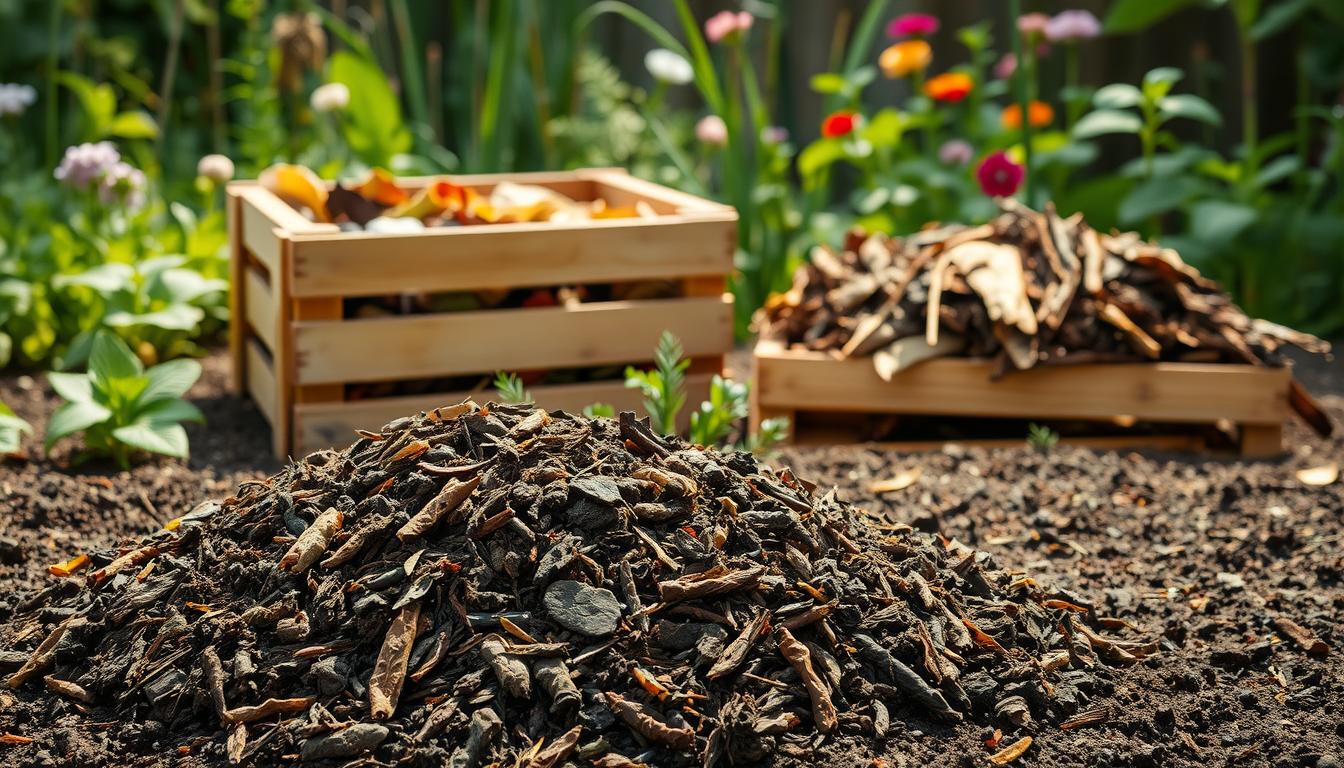Wondering about the power of organic gardening? Can DIY garden fertilizer really boost soil health and support green gardening? Yes, it can. Natural fertilizers offer lasting nutrients and are kind to the planet. They help your garden grow strong and healthy, all while being gentle on the environment.
Introduction to Natural Fertilizers
Creating natural fertilizer is key to eco-friendly gardening. Organic gardening, including DIY fertilizers, cuts down costs and encourages plants to grow well. Natural fertilizers avoid the dangers of synthetic ones, making your garden a balanced and vibrant place.

Table of Contents
Understanding the Benefits of Natural Fertilizer
When it comes to fertilizing your garden, natural fertilizers are a great choice. They are good for the environment and work well. Options like compost and homemade plant food give nutrients slowly, which is better for plants.
Natural fertilizers are better for the planet. They don’t pollute water like synthetic fertilizers do. They also make the soil healthier by adding organic matter and improving its structure.
Some natural fertilizers include compost, manure, and worm castings. Compost is full of nutrients and helps the soil. Manure comes from animals like horses and cows. Worm castings are good for plants in pots because they improve soil structure.
Using natural fertilizers helps the environment and makes plants grow better. The benefits include:
- Less water pollution and runoff
- Better soil structure and drainage
- More organic matter and soil health
- More soil microbes
- Nutrients released slowly, which is safer for plants
Natural fertilizers are a smart choice for your garden. They help your garden grow while being kind to the planet.
Common Ingredients for Homemade Fertilizer
Creating a sustainable garden is easier with homemade fertilizers. Look around your kitchen and yard for ingredients. This way, you can make your garden healthy and reduce waste.
Kitchen scraps like coffee grounds, eggshells, and banana peels are great for fertilizing. They’re full of nutrients like nitrogen, phosphorus, and potassium. For example, banana peels are packed with potassium, which is good for plants. Yard waste like leaves and grass clippings also make great compost.
Here are some other common ingredients for homemade fertilizer:
- Coffee grounds: rich in nitrogen and potassium
- Eggshells: provide calcium and pest control
- Banana peels: high in potassium and essential for fruiting plants
- Leaves and grass clippings: add nitrogen and potassium to the soil
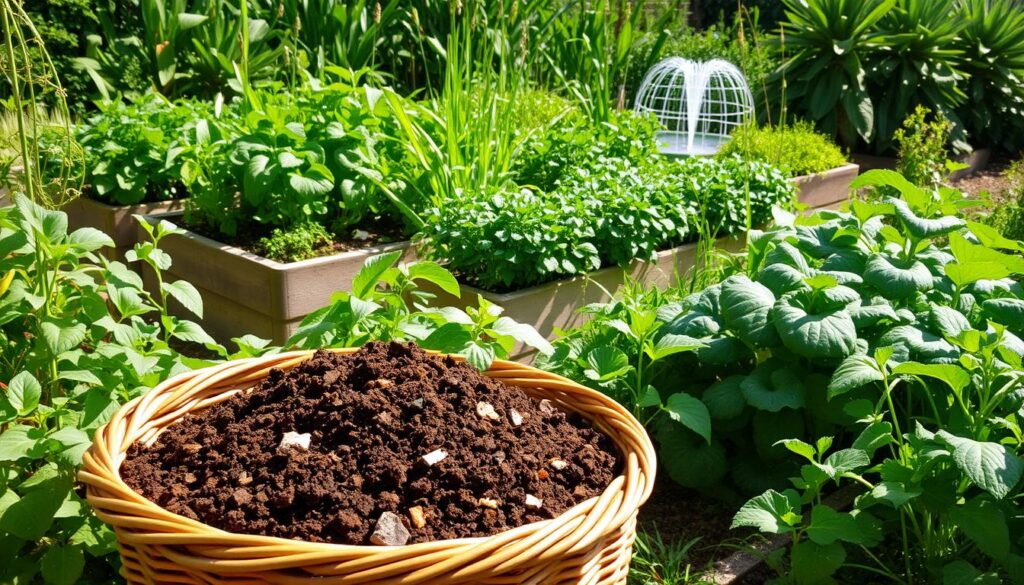
Using these ingredients, you can make a fertilizer that’s good for the planet. Always compost your ingredients first. This way, they’re ready to nourish your garden.
How to Create Your Own Compost
Composting is a smart way to make a natural plant food. You’ll need kitchen scraps, yard waste, and other organic stuff. The best mix is 30 parts “brown” stuff like leaves to 1 part “green” stuff like food waste.
It’s important to keep your compost moist, like a damp sponge. Make sure it gets hot, between 130º–170º F. Turn it often to keep it loose and aerated. The U.S. EPA says lots of trash can be composted, like 13% yard waste and 12% food waste.
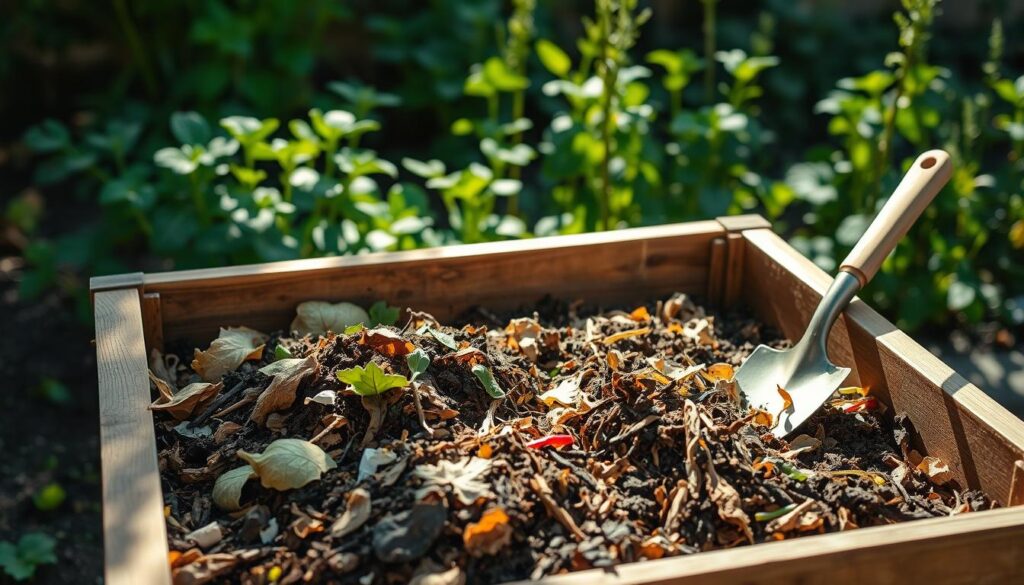
- Maintaining a compost bin size of at least 3’x3’x3′ or 27 cubic feet
- Turning the compost pile once or twice a year for cool composting, or as needed for hot composting
- Applying a 3- to 6-inch layer of compost as mulch to prevent water evaporation and discourage weed growth
By following these steps, you can make your own compost. Use it as a natural plant food to help plants grow and protect the environment.
Using Food Scraps for Fertilizer
Exploring organic gardening can lead to a surprising discovery. Food scraps can be a great source for DIY garden fertilizer. In the U.S., 24% of landfills are filled with food waste. Composting and using these scraps can help reduce this waste.
By composting, you can make a fertilizer that’s good for your plants and the planet. Banana peels, coffee grounds, and eggshells are excellent choices. They’re full of nutrients like nitrogen, phosphorus, and potassium. These are key for plant growth and fruit.
To use them, just add them to your compost or mix into the soil. This makes a fertilizer that’s both sustainable and eco-friendly.
Here are some benefits of using food scraps as fertilizer:
- Reduces food waste and landfill space
- Creates a nutrient-rich fertilizer for your garden
- Supports sustainable and environmentally friendly gardening practices
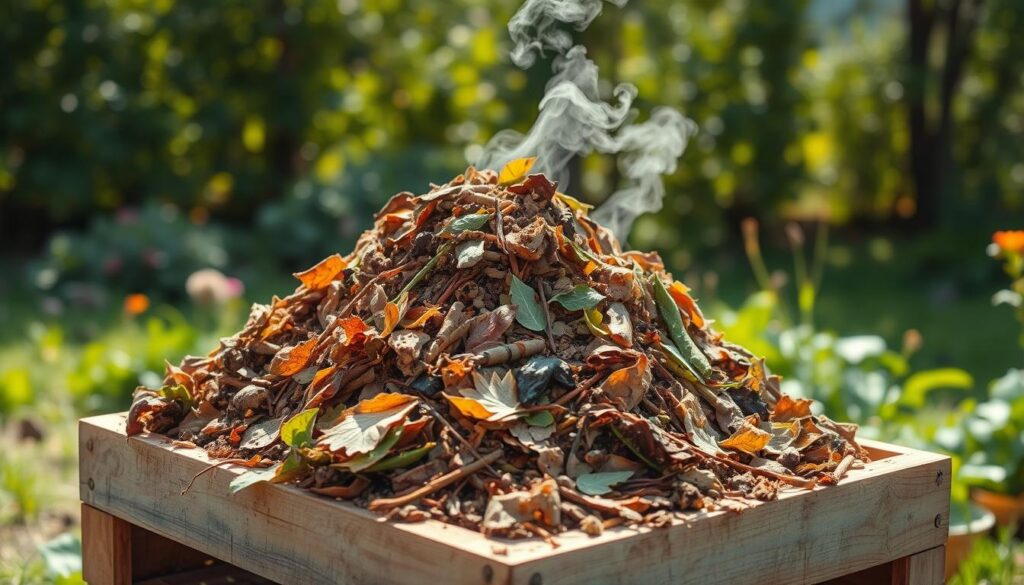
Adding food scraps to your organic gardening routine can make your garden thrive. It’s good for you and the planet. So, why not start using food scraps as fertilizer today?
Creating Liquid Fertilizer Solutions
Exploring eco-friendly fertilizing options for your garden is a great idea. Creating liquid fertilizer solutions is a valuable method. It uses natural ingredients to make a nutrient-rich liquid for your plants. This practice helps reduce environmental impact and promotes healthy growth.
One way to make a liquid fertilizer is by making comfrey tea. Comfrey is full of nutrients like potassium, making it perfect for fertilizers. To make comfrey tea, steep comfrey leaves in water. Then, use the liquid as a fertilizer. This method is eco-friendly, using a natural resource to help plants grow.
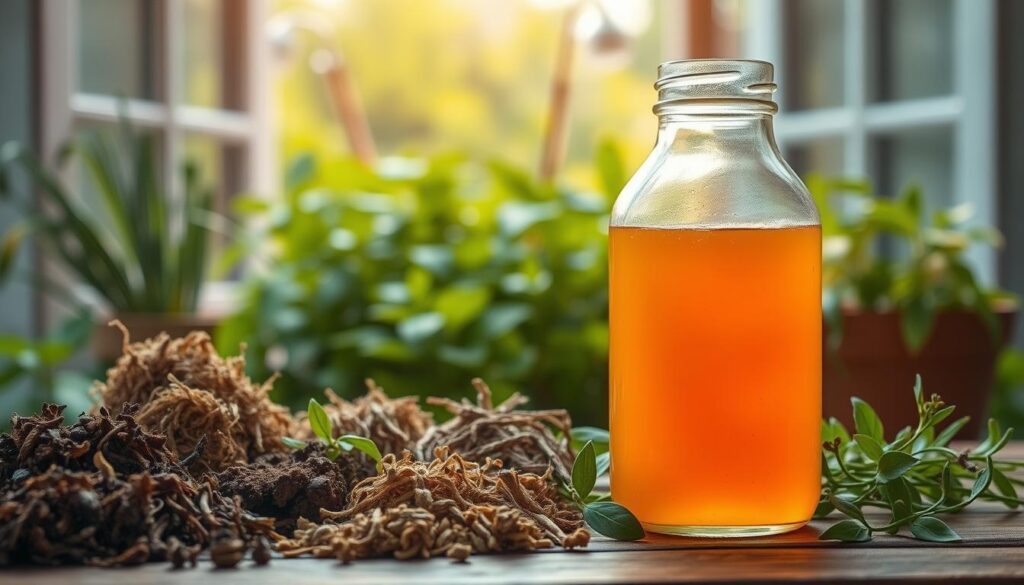
Another option is using worm castings. Worm castings are a natural, sustainable way to add nutrients to your soil. Mix worm castings with water to create a liquid fertilizer. This is a key part of sustainable gardening, reducing waste and promoting healthy soil.
Other ingredients for liquid fertilizer solutions include:
- Stinging nettles, which are rich in nitrogen and other nutrients
- Dandelions, which contribute potassium and other nutrients
- Yarrow, which is high in phosphorus and other essential nutrients
Using these natural ingredients, you can create a liquid fertilizer solution for your plants. This eco-friendly approach helps promote healthy growth while reducing environmental impact.
Understanding NPK Ratios in Fertilizers
In organic gardening, a nutrient-rich soil amendment is key for plant growth. The NPK ratio is important. It shows the nitrogen, phosphorus, and potassium levels in a fertilizer. Knowing NPK ratios helps pick the best fertilizer for your plants.
The NPK ratio is shown as three numbers. These numbers tell you the percentage of each nutrient. For instance, a 10-10-10 fertilizer has 10% of each. Different plants need different nutrients, so picking the right NPK ratio is crucial.
Here are some common NPK ratios and their uses:
- 10-10-10: General-purpose fertilizer for most plants
- 5-10-10: Fertilizer for tomatoes and root crops, with a higher phosphorus content
- 20-2-6: Fertilizer for lawns, with a higher nitrogen content
Choosing the right NPK ratio can greatly impact plant growth and health. A nutrient-rich soil amendment with the correct NPK ratio supports healthy plant development. This improves your organic gardening efforts.
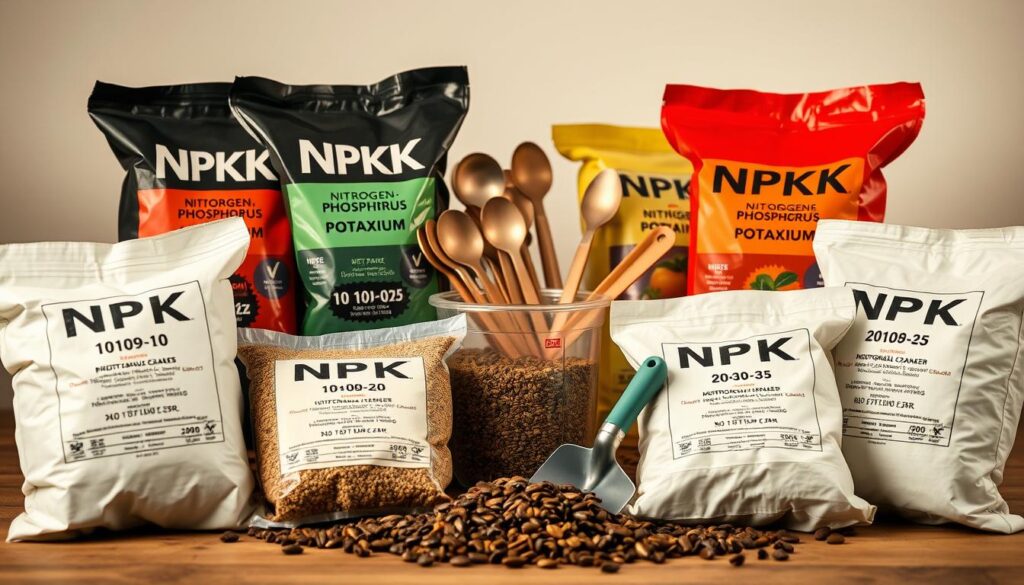
Applying Natural Fertilizers Effectively
When you’re ready to use your DIY garden fertilizer, think about when and how to apply it. Composting is key to making soil rich in nutrients for your plants. It’s important to match the fertilizer to your plants’ needs, including the type and how often to use it.
A good DIY garden fertilizer gives your plants the nutrients they need to grow well. For instance, nitrogen helps with leaf growth, and phosphorus helps with roots. Making your own fertilizer from compost can meet your plants’ specific needs.
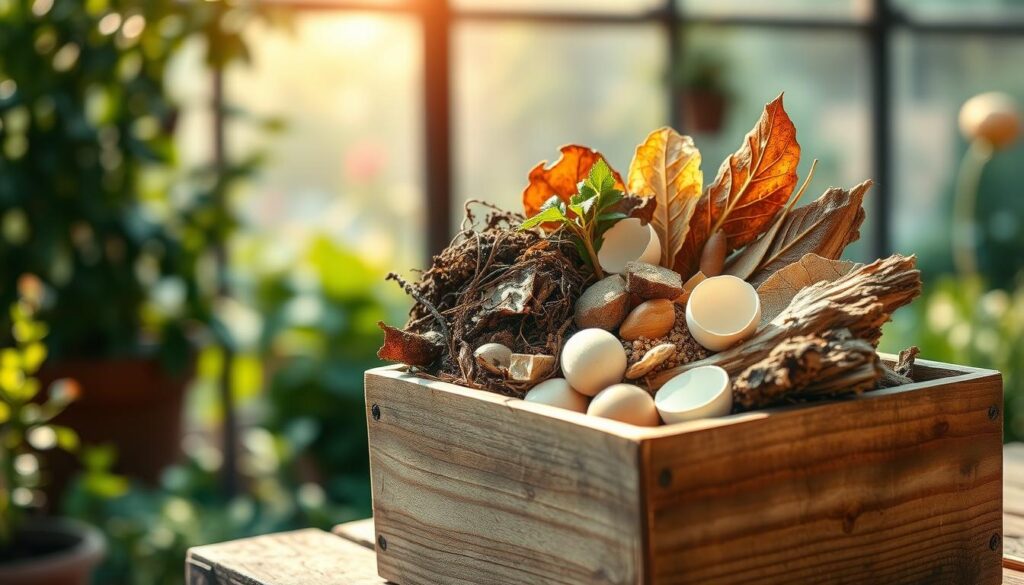
- Apply fertilizer when plants are growing new leaves and stems.
- Use a mix of fertilizer and compost for a balanced soil.
- Water plants well after fertilizing to avoid damage.
By following these tips and using DIY garden fertilizer, you can have a garden full of life and nutrients. Composting is a big part of this. It helps your garden grow strong and healthy, leading to a great harvest and a beautiful garden.
Measuring Nutrient Needs for Your Garden
To make sure your garden gets the right nutrients, you need to measure its needs. Start with a soil test, which costs about $20 from university extension services. You’ll get the results in a week, showing the soil’s pH and nutrient levels.
Using sustainable garden practices like soil testing helps find the best nutrient mix for your garden. This lets you add the right nutrients, avoiding too much and harming the environment. Eco-friendly fertilizing options, like compost or manure, keep the soil healthy and cut down on synthetic fertilizers.
Here are some important tips for measuring nutrient needs:
- Retest soil every five years to keep nutrient balance right
- Check fertilizer labels for nutrient percentages, like a 5-3-3 label means 5% nitrogen, 3% phosphorus, and 3% potassium
- Give nutrients based on what plants need, like more nitrogen for roses or phosphorus for fruits
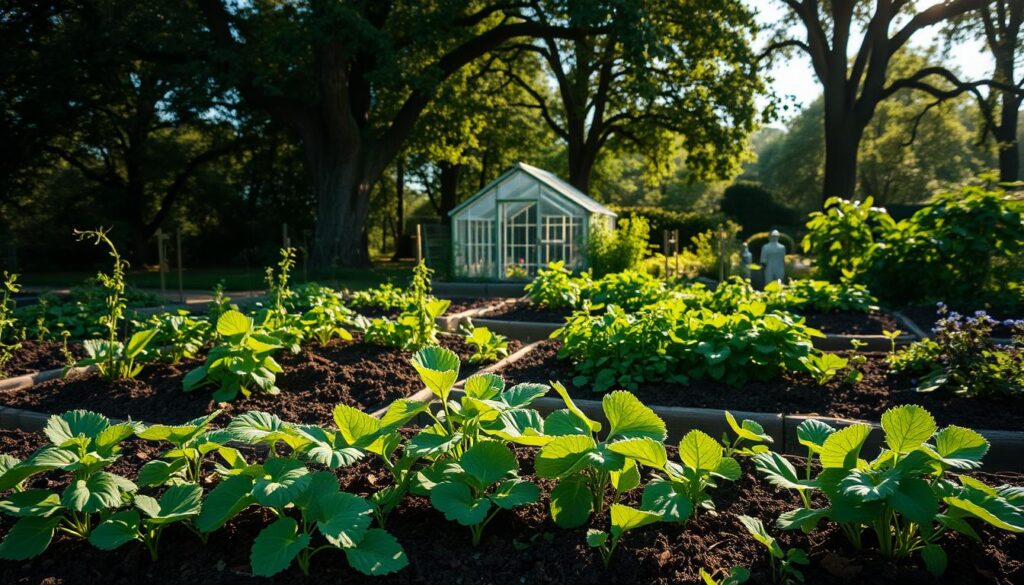
By following these tips and using sustainable garden practices, you can have a garden that thrives with eco-friendly fertilizing. Keep an eye on your plants and change your fertilizing plan as needed for the best growth and health.
Maintaining a Fertility Schedule for Your Garden
To keep your garden healthy all year, you need a steady plan for soil fertility. As an organic gardener, setting up a regular schedule for fertilizing is key. Start by testing your soil seasonally to check nutrient levels and adjust your fertilizing plan.
When using organic fertilizers, timing is everything. Spring is the best time to add compost or aged manure for most vegetables. This gives your plants the nutrients they need as they grow. For perennials, fertilize in early spring before they start growing again.
Keep an eye on your plants all growing season. Watch for signs of nutrient shortages or imbalances. Adjust your fertilizing plan as needed. This way, you’ll keep your garden thriving and full of life, ready for a bountiful harvest every year.
FAQ
Why should I choose natural fertilizers over chemical fertilizers?
Natural fertilizers are better for the environment and safe for pets and kids. They help create a healthy garden ecosystem. Using them is key to organic gardening and making your garden eco-friendly.
What are the different types of natural fertilizers available?
There are many natural fertilizers like compost, homemade food, kitchen scraps, yard waste, and manure. These practices make your soil rich and sustainable.
How do I create my own compost?
To make compost, pick the right materials and understand the process. Follow tips for effective composting. This makes a nutritious, sustainable plant food.
How can I use food scraps as fertilizer?
You can use banana peels, coffee grounds, and eggshells to make fertilizer. These organic ingredients are easy to add to your garden.
What are some examples of liquid fertilizer solutions I can make at home?
You can make liquid fertilizers like comfrey tea, worm castings, and fermented plant juice. These are eco-friendly and give your plants a nutrient boost.
How do I understand NPK ratios in fertilizers?
NPK ratios show the nitrogen, phosphorus, and potassium levels in fertilizers. Knowing these helps match the fertilizer to your plants’ needs, ensuring they get the nutrients they need.
How do I effectively apply natural fertilizers?
To apply natural fertilizers well, know when and how to use them and water properly. A DIY garden fertilizer ensures your plants get nutrients in a sustainable way.
How do I measure the nutrient needs of my garden?
To find out what your garden needs, test the soil and understand the results. This helps you tailor your fertilizing to your plants’ needs.
How do I maintain a fertility schedule for my garden?
To keep your garden healthy, plan your fertilization, watch your plants, and adjust as needed. Organic gardening and a nutrient-rich soil amendment help your plants thrive all season.
Source Links
- Feed Your Garden Naturally: DIY Organic Fertilizers Made Easy – https://www.sproutboxgarden.com/blogs/news/diy-organic-fertilizer
- Gardener shares simple method for making natural fertilizer at home: ‘I have to start doing this’ – https://www.thecooldown.com/green-home/homemade-plant-fertilizer-garden-waste/
- The Ultimate Guide to Natural Fertilizers: Benefits, Types, and DIY Tips for a Healthier Garden – # – https://spicymoustache.com/the-ultimate-guide-to-natural-fertilizers-benefits-types-and-diy-tips-for-a-healthier-garden/
- Garden Fertilizer Basics | University of Maryland Extension – https://extension.umd.edu/resource/garden-fertilizer-basics
- Boosting Plant Health Naturally: Top Natural Fertilizers for Your Garden – Garden Savvy – https://gardensavvy.com/gardening-blog/organics/boosting-plant-health-naturally-top-natural-fertilizers-for-your-garden/?srsltid=AfmBOooRamjTYhZpAWst5060VuqQ8wJNTG0baTHvCg7s71lKG_zE2J9x
- Homemade Fertilizer for Plants: 10 Best Natural Recipes – https://lomi.com/blogs/news/homemade-fertilizer-for-plants?srsltid=AfmBOoq4d4Zsv1xBvCAI41a1Ce9tuFfpaMF0UGpbJNf_IWPd0IELYCfF
- 15 Easy Organic Fertilizers to Make at Home – Sustainable Holly – https://sustainableholly.com/15-easy-organic-fertilizers-to-make-at-home/
- Homemade fertilizer – compost ingredients to consider – https://www.coastalillustrated.com/ch/column_gardening/article_41c6e290-40ef-5b0e-bf6a-897ec9e9f7ec.html
- How to Make Compost at Home – https://extension.umd.edu/resource/how-make-compost-home
- Easy Steps to Make Compost for Your Garden – https://www.thespruce.com/how-to-make-compost-p2-1761841
- Kitchen Waste Composting: Transforming Scraps into Soil Gold – HomeBiogas – https://www.homebiogas.com/blog/kitchen-waste-composting/?srsltid=AfmBOorm1Ju2LBCDJThK_9DBiw6vAkWzttmDWUfxtneAM8Ud-9j5JCiK
- Be Green Pro – https://www.begreen.pro/blog/composting-101-turning-kitchen-scraps-into-organic-lawn-gold
- Converting Food Waste to Fertilizer | Shapiro – https://shapiroe.com/blog/food-waste-to-fertilizer/
- 7 Easy Ways to Make Organic Liquid Fertilizer | EcoMENA – https://www.ecomena.org/liquid-organic-fertilizer/
- Top 10 Eco-Friendly DIY Garden Hacks – Natural Fertilizers and Pest Control – https://www.westcoastseeds.com/blogs/wcs-academy/top-10-eco-friendly-diy-garden-hacks-natural-fertilizers-and-pest-control?srsltid=AfmBOopYo9-zzwu9gIxSx-6HYizufW_hBjx0uU2HmhDof_ouQwO-uemt
- Use These Garden Plants to Make Your Own Liquid Plant Feeds – https://www.treehugger.com/use-garden-plants-make-liquid-feeds-5210116
- N-P-K Ratio: What Do The Numbers On Fertilizer Mean? – https://www.almanac.com/n-p-k-ratio-what-do-numbers-fertilizer-mean
- Fertilizer NPK Ratios Are Not What You Think They Are (and Why Everybody Else Is Wrong) – https://gardenbetty.com/npk-fertilizer/
- Fertilizing in the Home Garden – https://yardandgarden.extension.iastate.edu/how-to/fertilizing-home-garden
- How to Boost Plant Health with the Magic of Organic Fertilizers! – https://www.nutriharvest.com/blogs/celebrate-growing-today/organic-fertilizers?srsltid=AfmBOopaSqqZJBm2b5IIT7TLfwvJrs1UO6FtqVHd-iErY6SRJj2EwS2o
- Essential Nutrients for Your Lawn and Garden – https://www.thisoldhouse.com/gardening/21018839/the-right-nutrients-for-a-knockout-garden
- All About Fertilizer: Everything You Need To Know About Feeding Plants – https://www.gardeningknowhow.com/garden-how-to/soil-fertilizers/all-about-fertilizer
- Best Fertilizers: Choosing the Right Nutrients for Your Garden | Big Easy Lawn Care – https://www.bigeasylawncare.com/understanding-fertilizers-choosing-the-right-nutrients-for-your-garden/
- Let’s Grow! How and When to Fertilize Your Vegetable Garden – https://www.almanac.com/how-fertilize-your-vegetable-garden
- Building and maintaining soil fertility: utilizing the decay cycle to increase the velocity of nutrients accumulation – https://www.theresistancegarden.com/building-and-maintaining-soil-fertility-utilizing-the-decay-cycle-to-increase-the-velocity-of-nutrients-accumulation/
- Turning Cover Crops into Green Manure – Organic Gardening – https://www.groworganic.com/blogs/articles/turning-cover-crops-into-green-manure?srsltid=AfmBOorJwA873E_6tMHlD1MFpBFcE87n_ZFB8gKjxeZzmgh46C71XTJv

